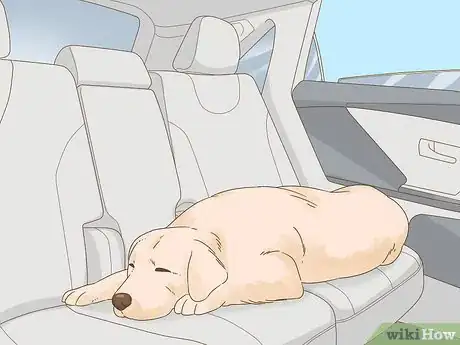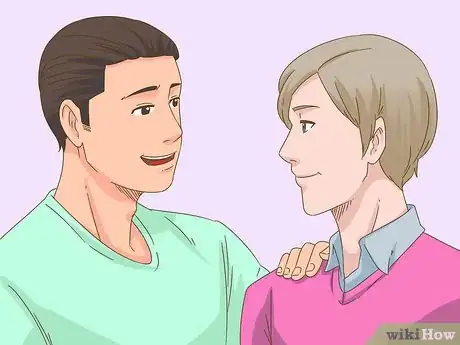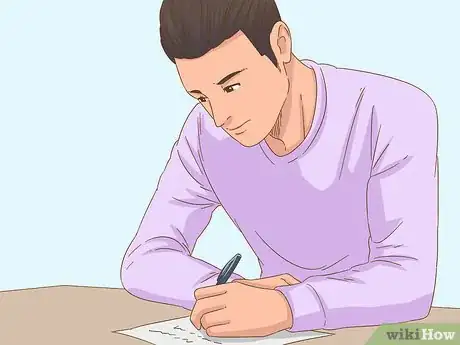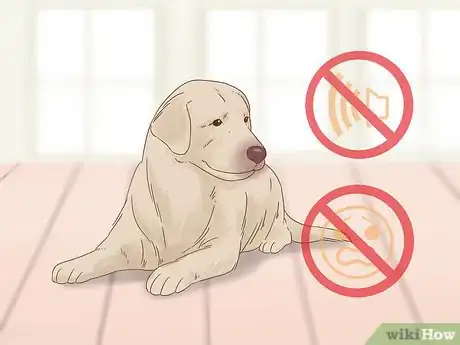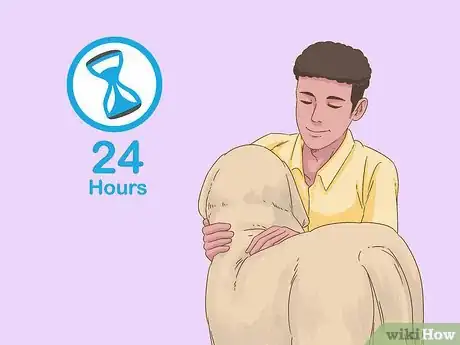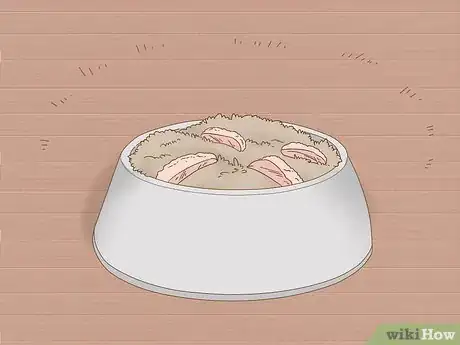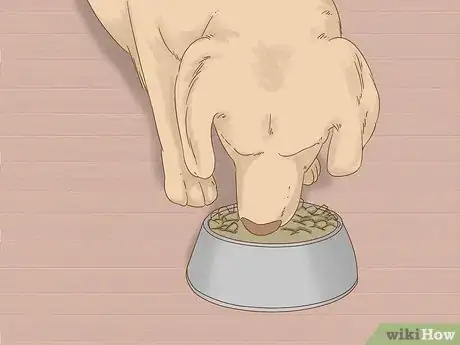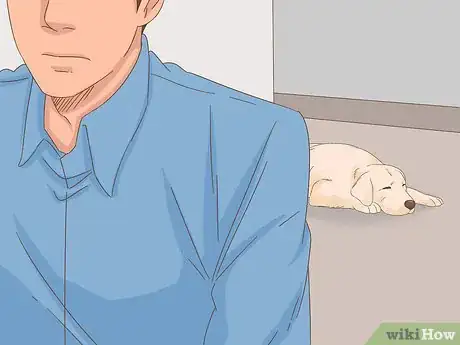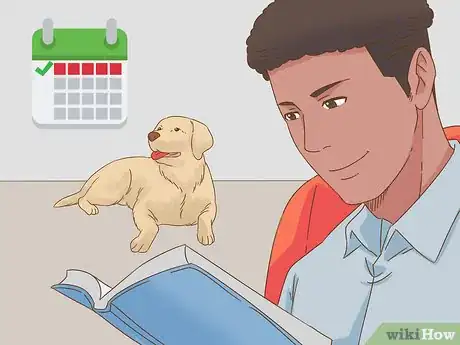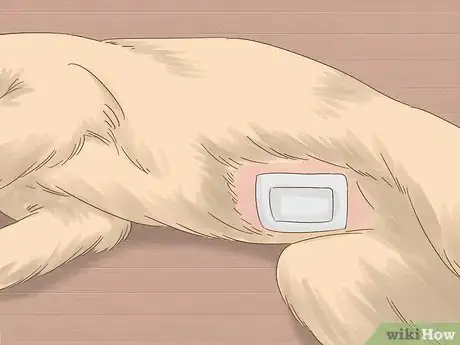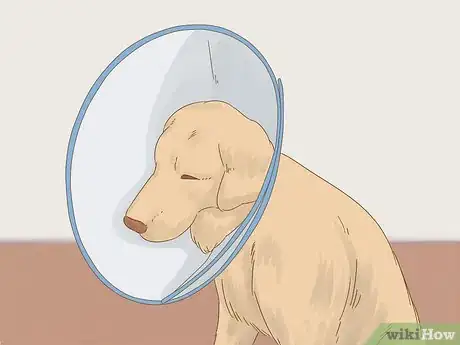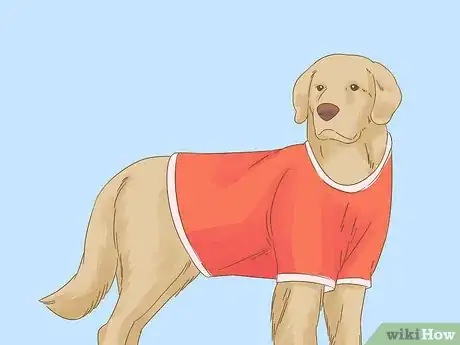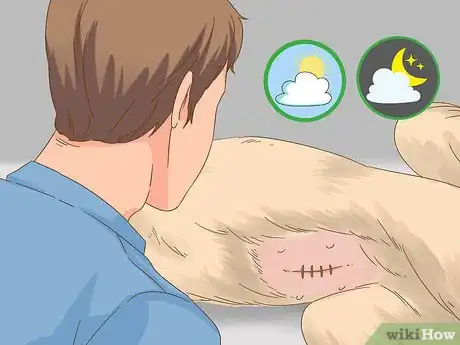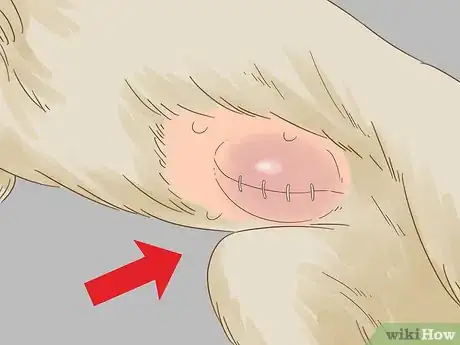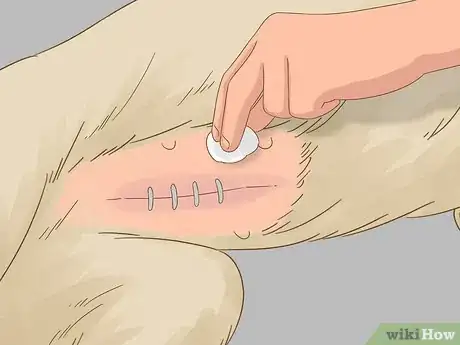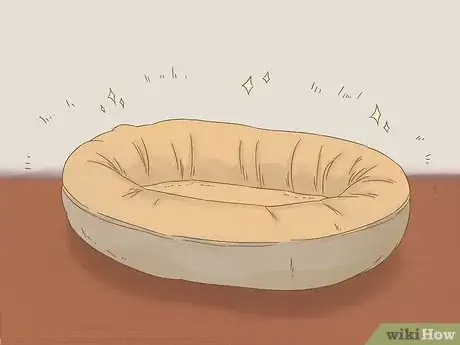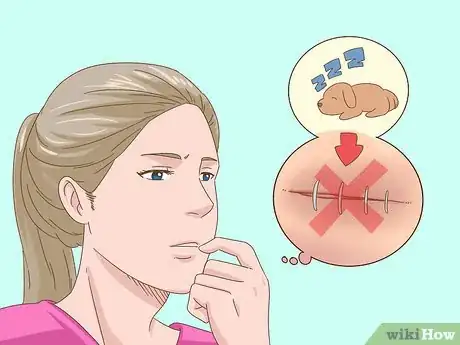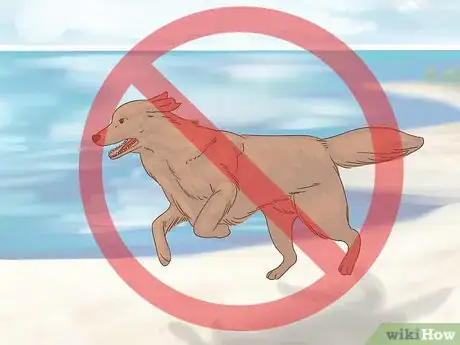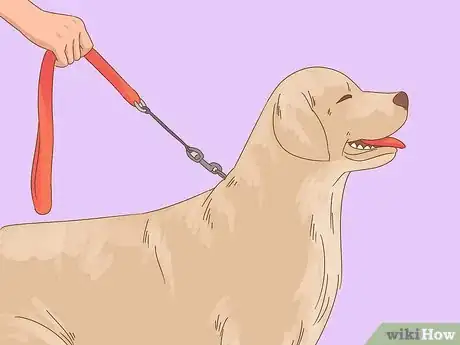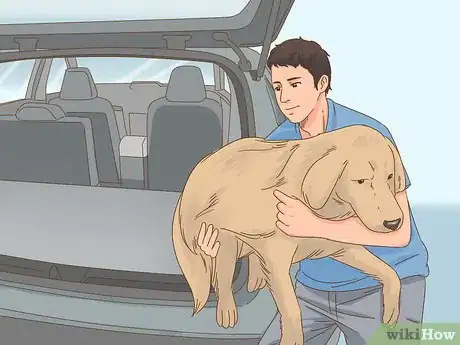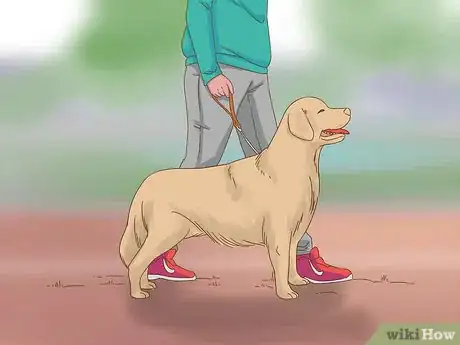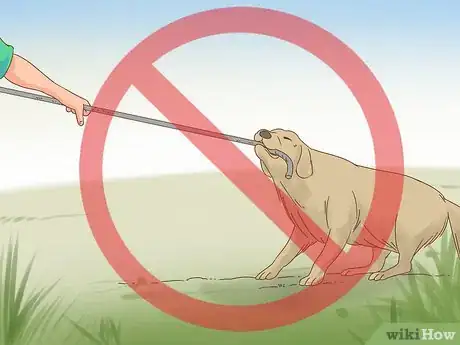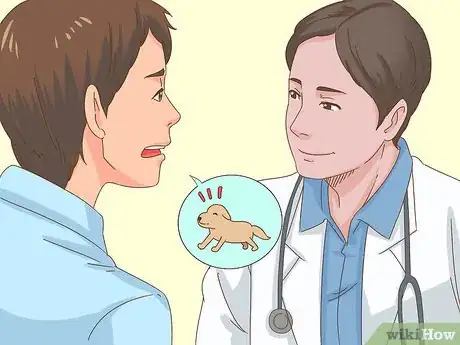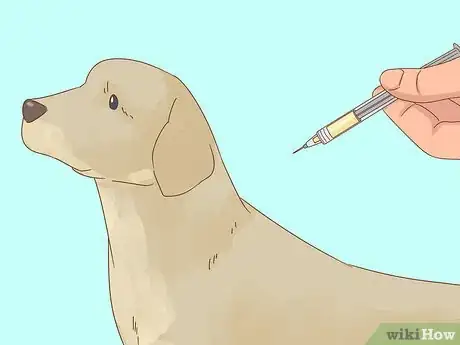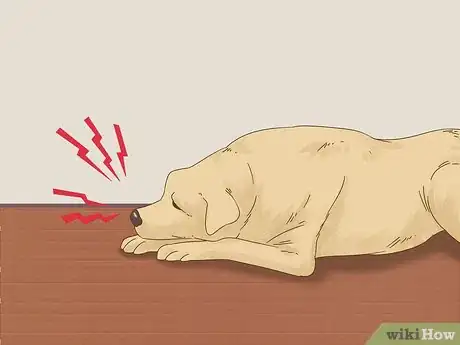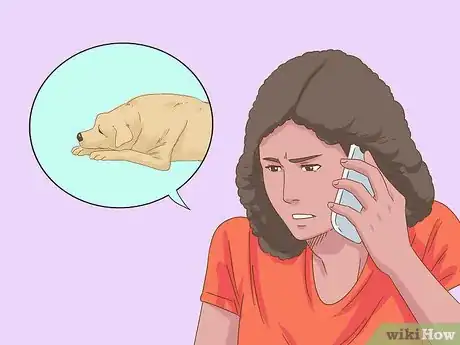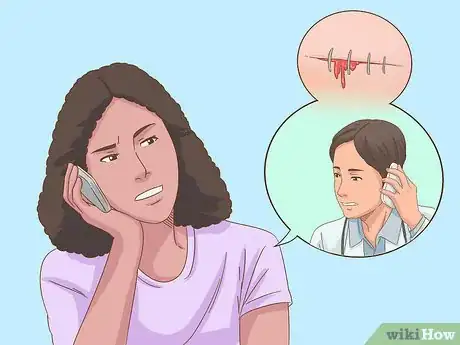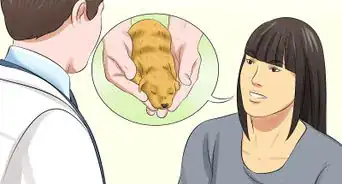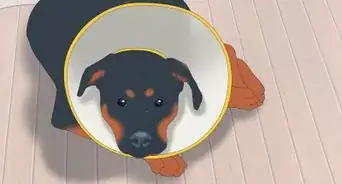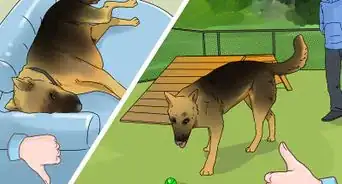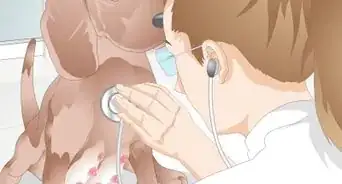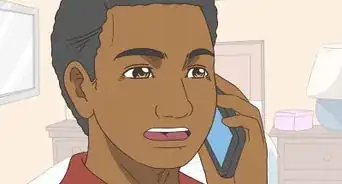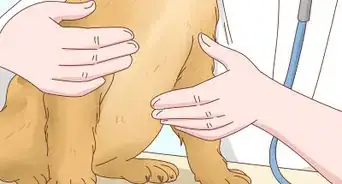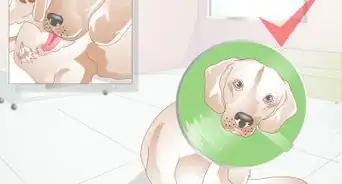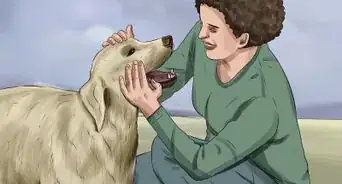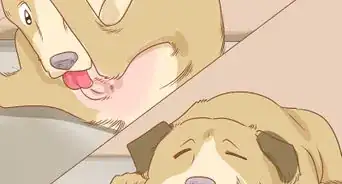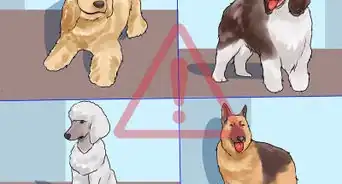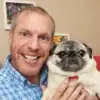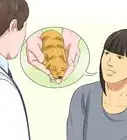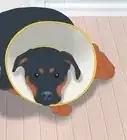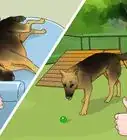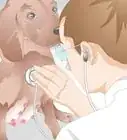This article was co-authored by Brian Bourquin, DVM. Brian Bourquin, better known as “Dr. B” to his clients, is a Veterinarian and the Owner of Boston Veterinary Clinic, a pet health care and veterinary clinic with three locations, South End/Bay Village, the Seaport, and Brookline, Massachusetts. Boston Veterinary Clinic specializes in primary veterinary care, including wellness and preventative care, sick and emergency care, soft-tissue surgery, dentistry. The clinic also provides specialty services in behavior, nutrition, and alternative pain management therapies using acupuncture, and therapeutic laser treatments. Boston Veterinary Clinic is an AAHA (American Animal Hospital Association) accredited hospital and Boston’s first Fear Free Certified Clinic. Brian has over 19 years of veterinary experience and earned his Doctor of Veterinary Medicine from Cornell University.
wikiHow marks an article as reader-approved once it receives enough positive feedback. This article received 19 testimonials and 93% of readers who voted found it helpful, earning it our reader-approved status.
This article has been viewed 655,827 times.
Getting your female dog spayed is socially responsible. Removing her womb means she cannot get a uterine infection (pyometra), and if neutering takes place before her second season, it has a protective effect against the development of mammary cancer later in life. However, putting any animal through surgery can be nerve wracking. The care you give your pet after her operation can reduce the risk of postoperative complications and make her recovery comfortable.
Steps
Collecting Your Dog After Her Surgery
-
1Arrange for transportation for your dog. Your dog won't be allowed home until she is up on her feet and able to walk. However, this doesn't mean she should walk home. Carry a small dog in your arms, or arrange transport for a large dog.
- The vet may keep your dog overnight if she still seems loopy from the sedatives she was given, or if she cannot walk on her own.
-
2Ask a friend to come with you. Take a friend along when you collect your dog from the clinic. It is often tricky to remember instructions when you are anxious to see your furry companion again. Your friend can be an extra pair of ears, to listen for instructions that you might forget in the heat of the moment.
- A friend can also hold doors open and assist you in getting your dog into and out of the car.
Advertisement -
3Write down any questions you may have so that you can ask the vet when you arrive at the clinic. Most clinics give comprehensive verbal and written instructions describing what to do after your dog has had surgery. Before you arrive at the clinic, it is also a good idea to write down any questions you might have concerning postoperative care.
- Writing your questions down and going throughout them one by one with your vet may help you to feel more prepared to take care of your dog.
Caring for Your Dog Immediately After the Surgery
-
1Keep your dog’s environment calm and quiet. Once you get your dog home, she will need some peace and quiet so that she can rest and recover. Do not arrange surgery the same day as a big dinner party in the evening, as having a large group of people around will not be relaxing for your dog.
- You should also resist inviting people over to come and visit your dog. While she will of course be pleased to see these people, having them there will also make her want to get up and move around while she should be resting.
-
2Stay at home for 24 hours after your dog’s surgery. Many people wonder if they should stay home with their dog for days after surgery. This is not necessary. It is, however, a good idea to be home for the first 24 hours after surgery so that you can make sure that your dog is eating, alert, going to the toilet, and not in too much pain.[1]
- If anything happens that concerns you during this first 24 hour period then always phone your vet for advice.
- If you have no choice but to leave the house, consider getting a trusted pet sitter and walking her through this information.
-
3Feed your dog a light diet after the surgery. During the evening, after your dog’s anesthetic has begun to wear off, you will be able to feed her. However, give her a light meal, rather than her regular portions. The anesthetic can make some dogs feel nauseous, and eating a full meal may cause your dog to vomit.
- Consider a small portion of cooked chicken breast, rabbit, cod, or turkey along with a little white rice or pasta.
- Alternatively, you could get food that is designed for a dog experiencing nausea.
-
4Switch your dog back to a normal diet the day after surgery. It is fine to return your dog to a normal diet the following day. Keep in mind that it is normal for a dog who has had surgery to not defecate for two to three days.
-
5Try to only leave your dog for four hours at a time in the days after her surgery. During the first three to four days after her surgery, you can leave your dog alone for four hours at a time. These four hours will allow her time to sleep and rest, but will also help you to be around enough that you can spot problems she may have.
- Refer to the section on helping a dog in pain to find out what signs to look for.
-
6Relax your watch after four or five days. Assuming there have been no serious complications by this point, your dog should do fine when left at home alone. After this point, it's mostly a matter of giving her time to heal until the sutures are removed, 10-14 days after the surgery.
Keeping Your Dog from Licking the Wound
-
1Keep your dog’s bandage in place for 24 hours. Some clinics send the patient home with Primapore (an adhesive dressing) covering the incision. Keeping this in place for 24 hours allows a seal to form over the incision which protects it from getting infected with bacteria.
- Some clinics do not use Primapore anymore, as removing it can irritate the dog's skin.
-
2Get your dog a cone collar to keep her from licking the wound. Do not let your dog or any other animal lick the incision, as this carries a high risk of infection and breaking the stitches. To prevent her from doing this, there are a variety of cone collars to choose from. These collars are variously described as looking like an Elizabethan ruff, a lampshade, or a bucket with the bottom taken out. Most are made from clear plastic.
- Pick a collar that fits your dog. The narrow end of the collar sits around the dog's neck and is held in place with her regular collar. The wider end of the cone should project two to three inches (5–7.5 cm) beyond her nose, so the collar is between her and the wound.
- Alternatively, you can get the dog an inflatable neck brace, to prevent the dog from turning her head. These look a lot like life-saver inflatable rings and are fitted to the diameter of your dog's neck.
-
3Put an old T-shirt on your dog if you have other dogs. If you have several dogs, any number of them might try to lick your recovering dog’s wound. To keep this from happening, find a T-shirt that is large enough to cover your dog’s whole body down to where the incision was made. Have your dog wear the T-shirt for 10 to 14 days. Cotton T-shirts work well for this, as they are very breathable.[2] :
- Pull the t-shirt over your dog’s head and put her two front legs into each sleeve of the shirt. Pull the shirt down so that it covers the incision, and tie it up so she can walk around. If the shirt is long enough, you could also cut two holes in the bottom that you can put your dog’s back legs through.
- If the T-shirt becomes soiled, replace it with a clean one.
Caring for Your Dog’s Wound
-
1Check the incision every morning and evening. Look at the incision, but do not touch it. A healing wound should be dry, with no seepage of fluid from the incision. As part of the healing process, the wound edges may swell slightly which helps to push them together.
-
2Look for signs of infection. Be vigilant for signs of heat, swelling, or discharge from the wound. Contact the vet immediately if there is any blood or pus leaking from the incision. Most often the blood comes from a small blood vessel leaking out into the fat layer beneath the skin, rather than major internal hemorrhage, but call your vet regardless to make sure it is nothing serious.[3]
- Likewise, pus is usually a sign of a superficial infection at or just beneath the skin, rather than an infection tracking out of the abdomen. However, your dog may need antibiotics to settle the infection so that it doesn't delay the healing of the wound.
-
3Wash the incision only if it gets dirty. Unless advised to do so by your veterinarian, do not touch the incision. However, if your dog goes outside and gets a muddy tummy, then it is acceptable to gently wash dirt from the incision. To do this:
- Create a saltwater solution (a teaspoon (5 mL) of salt mixed into a pint (0.5 L) of water that has been boiled, then cooled to a skin-safe temperature). Dip cotton balls into the solution, and then gently dab them over the wound to remove any dirt or grime from the incision.
-
4Make sure your dog’s bedding is clean. If the wound is undressed and exposed to the air, make sure your dog sleeps on clean, dry bedding so that the wound doesn't get contaminated.
Helping Your Dog Get the Rest She Needs
-
1Understand why rest is important. The principle of rest is to avoid anything that might stretch the incision, increase blood pressure, or dislodge ligatures. In an ideal world, rests means just that—rest. Lots of lying around in bed, with no stairs, no jumping, and no walks.
-
2Do not allow your dog to exert herself. This means no runs, games of Frisbee, or playing catch. It also means no running up and down stairs or jumping on and off furniture. Think about borrowing a child's stair gate for the duration of your dog’s recovery so that you can block off the stairs.
- If you own a large dog who likes to sleep with you, do not let her walk up the stairs to get to your bed. If you are concerned about your dog’s health, you can sleep downstairs on the sofa beside her.
-
3Keep your dog restrained when she needs to relieve herself. Take your dog out into the yard on a collar and lead, rather than letting her roam freely. Keeping her on a lead can help you to restrain her and keep her from injuring herself if she sees something that she wants to chase.
-
4Help your dog in and out of cars. Don't let your dog jump in and out of your car. If necessary, take a friend with you to help lift a big dog into and out of the trunk when you collect her from the clinic or take her somewhere other than your home.
-
5Keep your dog on a leash once you start walking her again. If your dog is going stir crazy and has so much bottled energy she is bouncing or jumping at doors, check with the clinic to see if a short walk is okay. Always keep her on a leash during the walk.
- Three to four days after her surgery, you can consider taking your dog for a walk. Try to keep the walk to five minutes in length, and walk on flat ground.
-
6Do not play roughly with your dog. If you have other dogs in the house who want to rough-house with your recovering dog, keep them under constant supervision so that they can't jump on her. Do not play tug-o-war with your dog, or any other games that involve movement.
- If you are concerned that you cannot keep your other dogs under control, consider asking a friend to watch those dogs until your recovering dog’s stitches have been removed.
-
7Talk to your vet if you have a very hyperactive dog. If you have a hyperactive dog that absolutely refuses to take things quietly no matter how hard you try, let the veterinary clinic know. They may recommend a mild sedative to slow her down a little.
Helping Your Dog Deal with the Pain
-
1Give your dog the painkillers the vet gives you. As with any major surgical procedure, it is important to make sure the patient is not in pain. Most clinics use a combination of painkillers (an opioid and a non-steroidal) on the day of surgery, and send your dog home with an oral painkiller to continue taking at home.
- Keep in mind that some dogs are more sensitive and will feel more pain than others. The average length of time that pain relief is required is generally four to five days, but your dog may need more or less time.
- Do not use any unprescribed painkillers without veterinary advice.
-
2Look for signs that your dog is in pain. Each dog reacts differently to pain; some become vocal and whine, while others withdraw and try to hide. General signs of discomfort are listed below:[4] :
- Restlessness: Pacing, inability to settle, and sitting down and then standing again, can all be signs of discomfort.
- Vocalization: Whining and crying. This is sometimes an attempt to get attention rather than a sign of pain. Try to avoid fussing over the dog when she cries; if she learns that you will not reward her, but continues to whine, she is probably in pain.
- Body Posture: A dog in pain often wears a "miserable" expression with tipped down ears, doleful eyes and a lowered head. Her body is often hunched and she may not be able to lie in her favorite position.
- Behavior : Some dogs change behavior when in pain, of which one example is becoming snappy or aggressive. Other dogs withdraw, as if trying to hide away from the pain.
- Not eating or drinking: Some dogs (especially Labradors) eat no matter what, but others go off their food if uncomfortable.
-
3Contact your vet if you think your dog is in severe pain. If you feel you dog does not have adequate pain relief, contact the clinic. There are other painkillers, such as tramadol, which can be added to the NSAID prescription to top up her pain control.
-
4Call the vet if you notice serious symptoms. Most veterinarians want to schedule a check-up between three and ten days after the operation. However, should you become concerned before this, always contact the surgery for advice. Signs to watch for include:
- Not eating or drinking after 48 hours: Your dog should be eating by now and could be in pain if she is not. Don't wait the extra day before seeking advice.
- A discharge from the wound: A healing wound is usually dry. If there is a discharge, especially blood or pus, seek advice.
- Sickness or diarrhea : Sometimes the anesthetic agents can cause tummy upsets in sensitive animals, however, in a pet that has had recent surgery, bring her to the vet if you see that she is nauseous.
- Weakness, lethargy, or a swollen tummy: If your dog seems weak and is not recovering her energy, or if her figure changes and her tummy looks swollen, seek immediate vet advice.
Our Most Loved Articles & Quizzes
Expert Q&A
Did you know you can get expert answers for this article?
Unlock expert answers by supporting wikiHow
-
QuestionCan I leave my dog alone after being spayed?
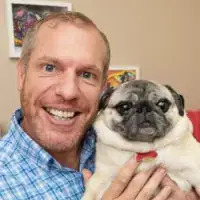 Brian Bourquin, DVMBrian Bourquin, better known as “Dr. B” to his clients, is a Veterinarian and the Owner of Boston Veterinary Clinic, a pet health care and veterinary clinic with three locations, South End/Bay Village, the Seaport, and Brookline, Massachusetts. Boston Veterinary Clinic specializes in primary veterinary care, including wellness and preventative care, sick and emergency care, soft-tissue surgery, dentistry. The clinic also provides specialty services in behavior, nutrition, and alternative pain management therapies using acupuncture, and therapeutic laser treatments. Boston Veterinary Clinic is an AAHA (American Animal Hospital Association) accredited hospital and Boston’s first Fear Free Certified Clinic. Brian has over 19 years of veterinary experience and earned his Doctor of Veterinary Medicine from Cornell University.
Brian Bourquin, DVMBrian Bourquin, better known as “Dr. B” to his clients, is a Veterinarian and the Owner of Boston Veterinary Clinic, a pet health care and veterinary clinic with three locations, South End/Bay Village, the Seaport, and Brookline, Massachusetts. Boston Veterinary Clinic specializes in primary veterinary care, including wellness and preventative care, sick and emergency care, soft-tissue surgery, dentistry. The clinic also provides specialty services in behavior, nutrition, and alternative pain management therapies using acupuncture, and therapeutic laser treatments. Boston Veterinary Clinic is an AAHA (American Animal Hospital Association) accredited hospital and Boston’s first Fear Free Certified Clinic. Brian has over 19 years of veterinary experience and earned his Doctor of Veterinary Medicine from Cornell University.
Veterinarian
-
QuestionWhat can I give my dog for pain after being spayed?
 Brian Bourquin, DVMBrian Bourquin, better known as “Dr. B” to his clients, is a Veterinarian and the Owner of Boston Veterinary Clinic, a pet health care and veterinary clinic with three locations, South End/Bay Village, the Seaport, and Brookline, Massachusetts. Boston Veterinary Clinic specializes in primary veterinary care, including wellness and preventative care, sick and emergency care, soft-tissue surgery, dentistry. The clinic also provides specialty services in behavior, nutrition, and alternative pain management therapies using acupuncture, and therapeutic laser treatments. Boston Veterinary Clinic is an AAHA (American Animal Hospital Association) accredited hospital and Boston’s first Fear Free Certified Clinic. Brian has over 19 years of veterinary experience and earned his Doctor of Veterinary Medicine from Cornell University.
Brian Bourquin, DVMBrian Bourquin, better known as “Dr. B” to his clients, is a Veterinarian and the Owner of Boston Veterinary Clinic, a pet health care and veterinary clinic with three locations, South End/Bay Village, the Seaport, and Brookline, Massachusetts. Boston Veterinary Clinic specializes in primary veterinary care, including wellness and preventative care, sick and emergency care, soft-tissue surgery, dentistry. The clinic also provides specialty services in behavior, nutrition, and alternative pain management therapies using acupuncture, and therapeutic laser treatments. Boston Veterinary Clinic is an AAHA (American Animal Hospital Association) accredited hospital and Boston’s first Fear Free Certified Clinic. Brian has over 19 years of veterinary experience and earned his Doctor of Veterinary Medicine from Cornell University.
Veterinarian
-
QuestionHow do I keep my dog from licking stitches without a cone?
 Brian Bourquin, DVMBrian Bourquin, better known as “Dr. B” to his clients, is a Veterinarian and the Owner of Boston Veterinary Clinic, a pet health care and veterinary clinic with three locations, South End/Bay Village, the Seaport, and Brookline, Massachusetts. Boston Veterinary Clinic specializes in primary veterinary care, including wellness and preventative care, sick and emergency care, soft-tissue surgery, dentistry. The clinic also provides specialty services in behavior, nutrition, and alternative pain management therapies using acupuncture, and therapeutic laser treatments. Boston Veterinary Clinic is an AAHA (American Animal Hospital Association) accredited hospital and Boston’s first Fear Free Certified Clinic. Brian has over 19 years of veterinary experience and earned his Doctor of Veterinary Medicine from Cornell University.
Brian Bourquin, DVMBrian Bourquin, better known as “Dr. B” to his clients, is a Veterinarian and the Owner of Boston Veterinary Clinic, a pet health care and veterinary clinic with three locations, South End/Bay Village, the Seaport, and Brookline, Massachusetts. Boston Veterinary Clinic specializes in primary veterinary care, including wellness and preventative care, sick and emergency care, soft-tissue surgery, dentistry. The clinic also provides specialty services in behavior, nutrition, and alternative pain management therapies using acupuncture, and therapeutic laser treatments. Boston Veterinary Clinic is an AAHA (American Animal Hospital Association) accredited hospital and Boston’s first Fear Free Certified Clinic. Brian has over 19 years of veterinary experience and earned his Doctor of Veterinary Medicine from Cornell University.
Veterinarian
References
- ↑ BSAVA Textbook of Veterinary Nursing. Cooper, Mullineaux, and Turner. BSAVA Publications.
- ↑ BSAVA Textbook of Veterinary Nursing. Cooper, Mullineaux, and Turner. BSAVA Publications.
- ↑ BSAVA Textbook of Veterinary Nursing. Cooper, Mullineaux, and Turner. BSAVA Publications.
- ↑ BSAVA Textbook of Veterinary Nursing. Cooper, Mullineaux, and Turner. BSAVA Publications.
About This Article
To care for your dog after spaying, feed her a light meal on the first evening just in case she's feeling nauseous from the anesthetic. Next, try to stay with your dog for the first 24 hours after the surgery so you can keep an eye on her. Then, get a cone collar to prevent her from licking her surgery wound, since this can interfere with healing. Finally, check the wound every day to make sure there are no signs of infection. For tips on helping your dog rest and avoid exertion, read on!
